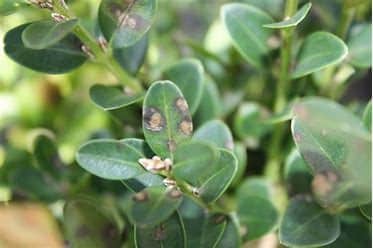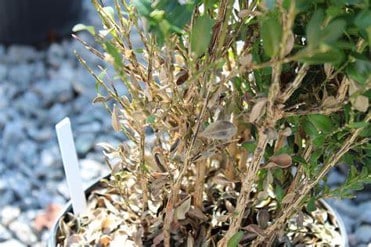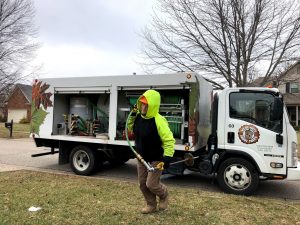What Is Boxwood Blight ?
Fungal Disease

A fungal disease that was first discovered in the United Kingdom in 1994, Boxwood Blight arrived in the United States in 2011. Since then, Boxwood Blight has been found in 27 states, including Central Kentucky (first discovered in in 2014). This fungal disease is caused by the fungus Calonectria pseudonaviculata. It is able to survive for up to three years without contact with a host plant.
Symptoms of Blight
What To Do When Symptoms Arise?
Symptoms of the fungal disease include: light or dark brown circular leaf spots, with darker borders; and rapid defoliation. On the infected stems, elongated, dark brown or black lesions show up. The roots can become home to the fungus also.
How is Boxwood Blight Created?

Optimal temperature for development of the disease, once it has attached to the Boxwood, is 64 degrees to 81 degrees Fahrenheit. Above 81 degrees, suppression of the disease has been observed.
The Blight fungal spores can spread by hitchhiking onto splashing water, wind-driven rain, yard tools, clothing, and also by carrying infected plants from one location to another. The spores can survive without a host for up to three weeks. If you are not sure on the exact fungus seen on your plant or trees contact one of our 7 certified arborists
How to Fix Boxwood Blight?
By following strict guidelines on handling Boxwoods, the
home owner and landscaper can eliminate and lessen the chances of preventing
the disease. These include but are not limited to: do not introduce new
Boxwoods into an area already landscaped with established Boxwoods without at
least three weeks in quarantine; do not use overhead irrigation; sanitize all
tools between usage; and mulch under the plants.
Bob Ray Co., Inc., Preventative Treatment for Boxwood Blight.

If you suspect your Boxwoods have contracted the Blight, contact Bob Ray Co. Inc. Tree Health.
Preventive treatments include yearly fungicidal sprays, administered during the time the fungus is most active (mid- to late Spring). A fungicidal spray will only help to protect against infection; the spray will not serve as a curative. As such, it is important to treat your Boxwoods if they are an integral part of your landscaping, or if you are in an area where the fungus has been found. Learn more about trees and plants by visiting out FAQ page on Tree Health.



